Management Business Environment: Critical Review Report for University
VerifiedAdded on 2022/08/20
|11
|2893
|12
Report
AI Summary
This report provides a critical review of management within the business environment, exploring various organizational structures such as line, functional, and committee structures, and their respective purposes. It delves into different legal structures in the private sector, including sole traders, partnerships, and limited companies, highlighting the legal requirements, risk assessment, and management practices associated with each. The report examines how organizational structures align with business objectives, using Nestle as a case study to illustrate strategic planning and the importance of training and stakeholder consultation. It also discusses the complexities inherent in business structures, emphasizing the impact of hierarchy, delegation, and adaptability to new trends. Key findings emphasize the significance of legal parameters, training, and strategic alignment for business success. The report stresses the need for businesses to adapt to the changing environment and adopt the latest versions of legislations into the business.
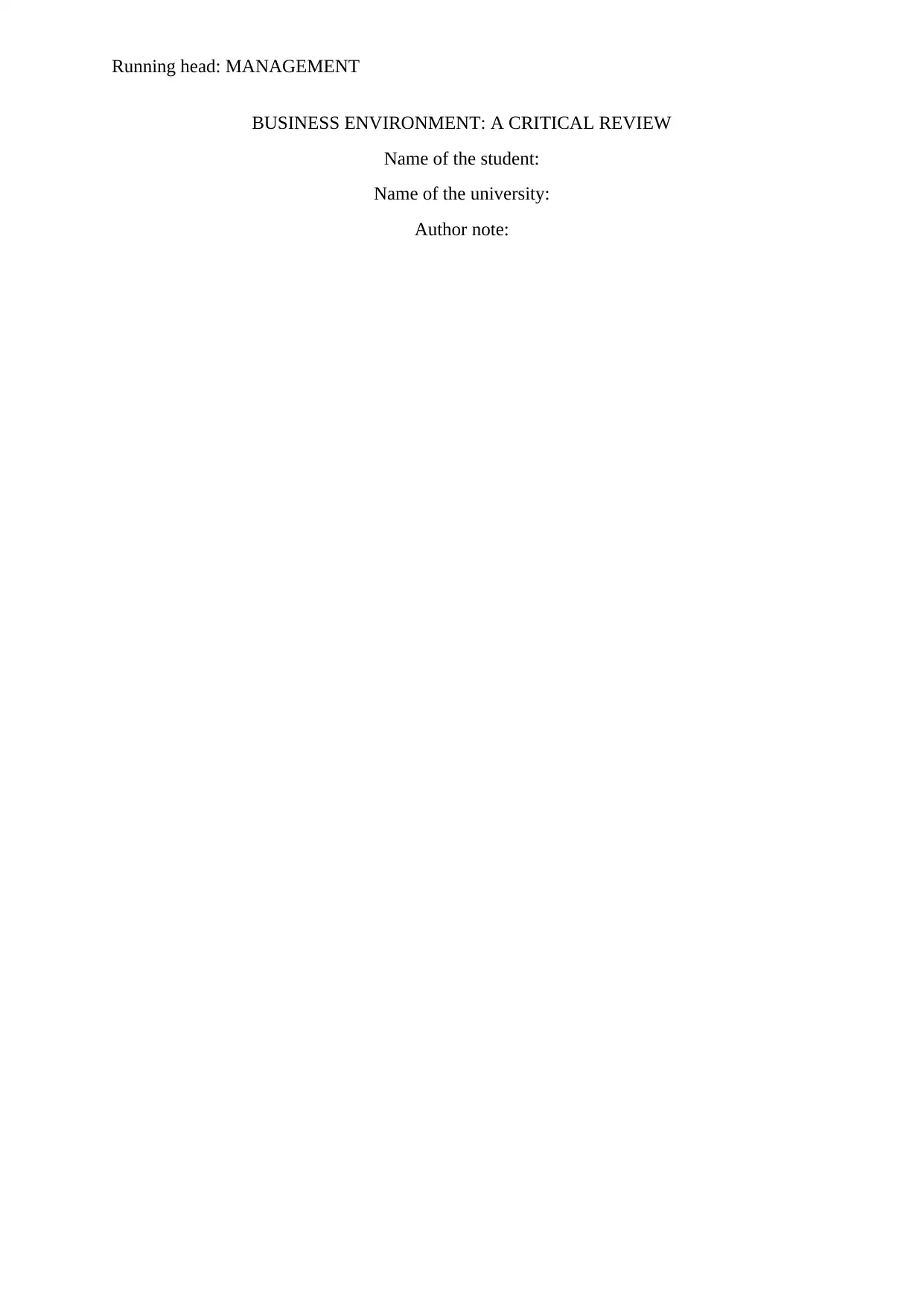
Running head: MANAGEMENT
BUSINESS ENVIRONMENT: A CRITICAL REVIEW
Name of the student:
Name of the university:
Author note:
BUSINESS ENVIRONMENT: A CRITICAL REVIEW
Name of the student:
Name of the university:
Author note:
Paraphrase This Document
Need a fresh take? Get an instant paraphrase of this document with our AI Paraphraser
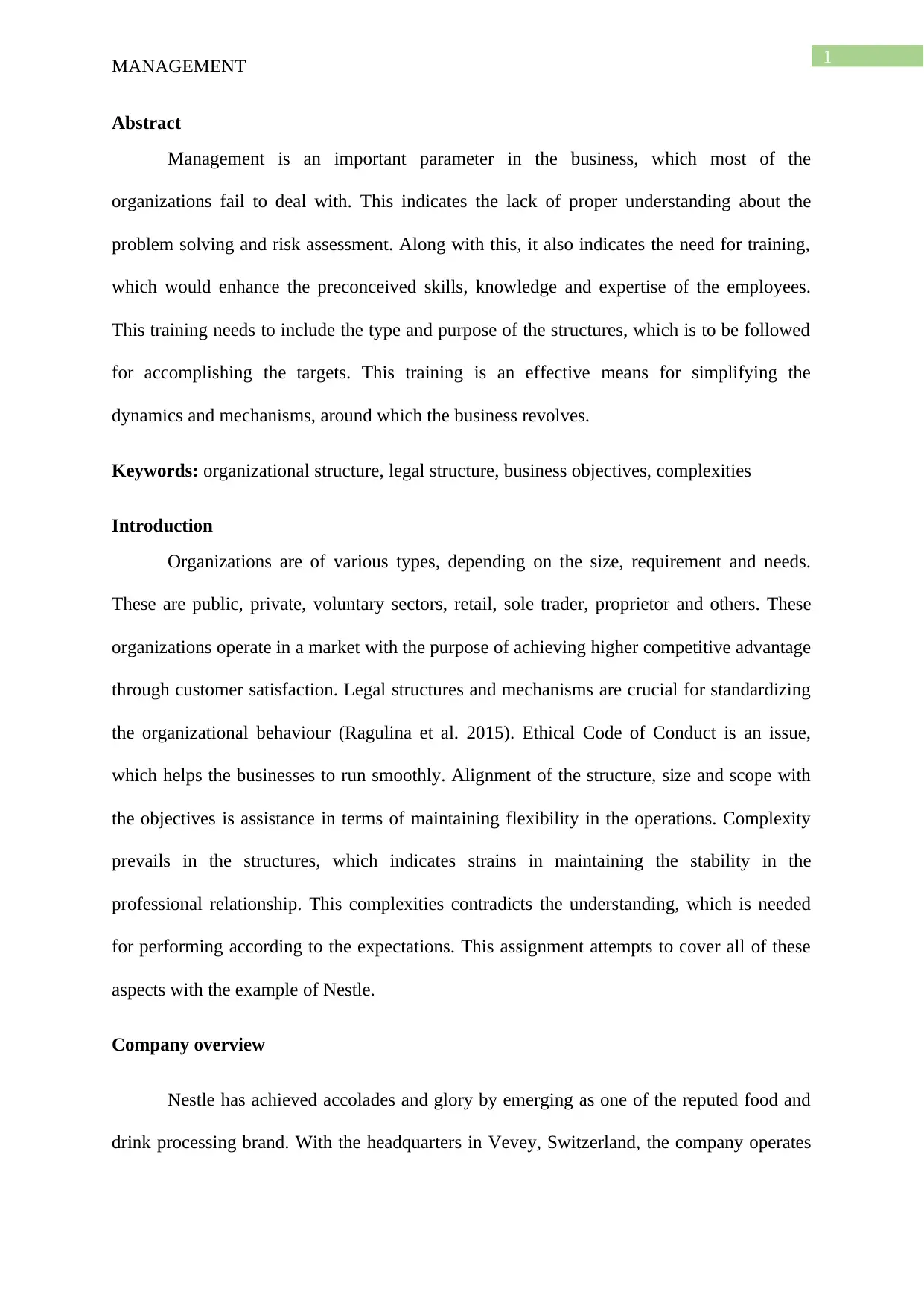
1
MANAGEMENT
Abstract
Management is an important parameter in the business, which most of the
organizations fail to deal with. This indicates the lack of proper understanding about the
problem solving and risk assessment. Along with this, it also indicates the need for training,
which would enhance the preconceived skills, knowledge and expertise of the employees.
This training needs to include the type and purpose of the structures, which is to be followed
for accomplishing the targets. This training is an effective means for simplifying the
dynamics and mechanisms, around which the business revolves.
Keywords: organizational structure, legal structure, business objectives, complexities
Introduction
Organizations are of various types, depending on the size, requirement and needs.
These are public, private, voluntary sectors, retail, sole trader, proprietor and others. These
organizations operate in a market with the purpose of achieving higher competitive advantage
through customer satisfaction. Legal structures and mechanisms are crucial for standardizing
the organizational behaviour (Ragulina et al. 2015). Ethical Code of Conduct is an issue,
which helps the businesses to run smoothly. Alignment of the structure, size and scope with
the objectives is assistance in terms of maintaining flexibility in the operations. Complexity
prevails in the structures, which indicates strains in maintaining the stability in the
professional relationship. This complexities contradicts the understanding, which is needed
for performing according to the expectations. This assignment attempts to cover all of these
aspects with the example of Nestle.
Company overview
Nestle has achieved accolades and glory by emerging as one of the reputed food and
drink processing brand. With the headquarters in Vevey, Switzerland, the company operates
MANAGEMENT
Abstract
Management is an important parameter in the business, which most of the
organizations fail to deal with. This indicates the lack of proper understanding about the
problem solving and risk assessment. Along with this, it also indicates the need for training,
which would enhance the preconceived skills, knowledge and expertise of the employees.
This training needs to include the type and purpose of the structures, which is to be followed
for accomplishing the targets. This training is an effective means for simplifying the
dynamics and mechanisms, around which the business revolves.
Keywords: organizational structure, legal structure, business objectives, complexities
Introduction
Organizations are of various types, depending on the size, requirement and needs.
These are public, private, voluntary sectors, retail, sole trader, proprietor and others. These
organizations operate in a market with the purpose of achieving higher competitive advantage
through customer satisfaction. Legal structures and mechanisms are crucial for standardizing
the organizational behaviour (Ragulina et al. 2015). Ethical Code of Conduct is an issue,
which helps the businesses to run smoothly. Alignment of the structure, size and scope with
the objectives is assistance in terms of maintaining flexibility in the operations. Complexity
prevails in the structures, which indicates strains in maintaining the stability in the
professional relationship. This complexities contradicts the understanding, which is needed
for performing according to the expectations. This assignment attempts to cover all of these
aspects with the example of Nestle.
Company overview
Nestle has achieved accolades and glory by emerging as one of the reputed food and
drink processing brand. With the headquarters in Vevey, Switzerland, the company operates
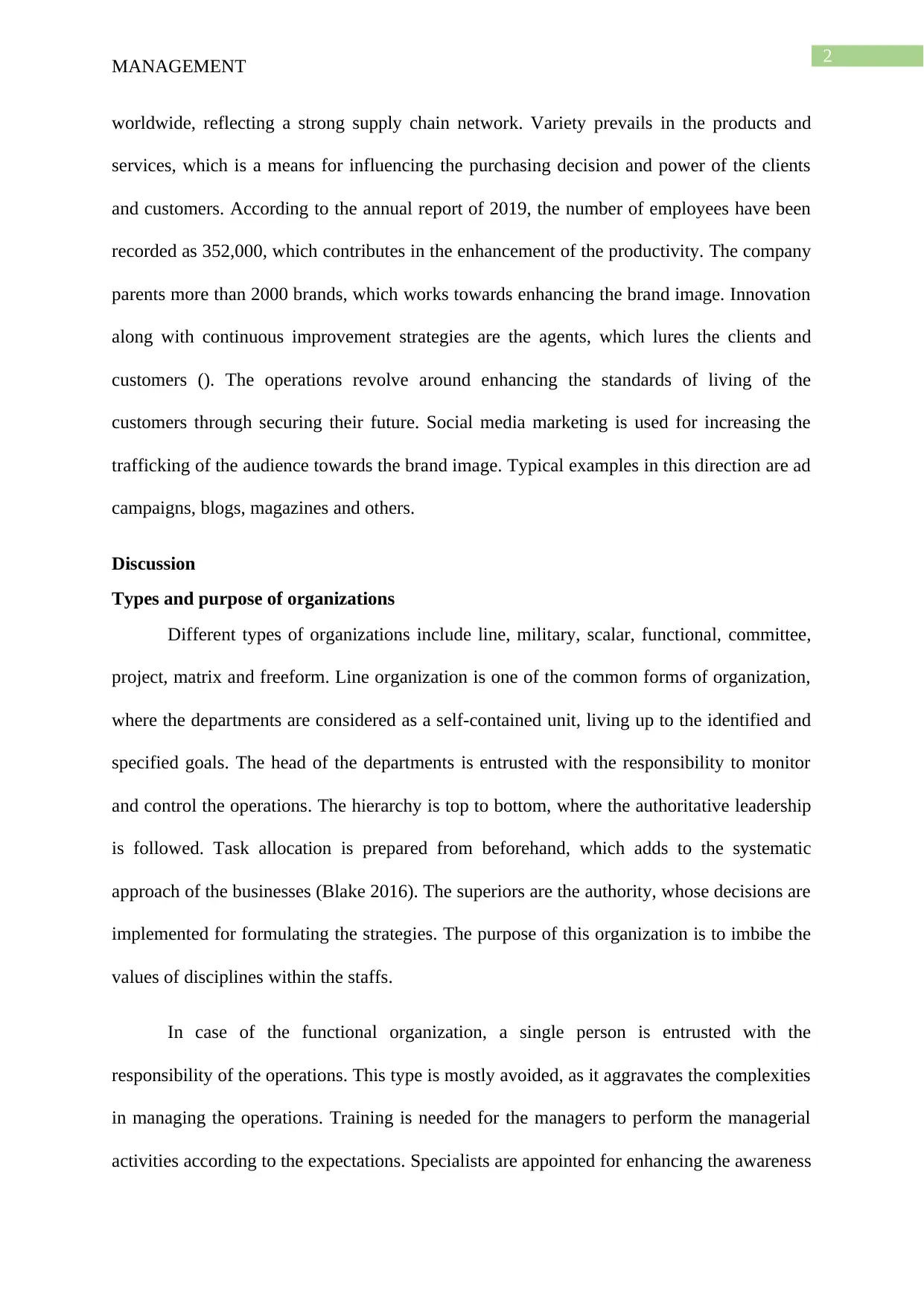
2
MANAGEMENT
worldwide, reflecting a strong supply chain network. Variety prevails in the products and
services, which is a means for influencing the purchasing decision and power of the clients
and customers. According to the annual report of 2019, the number of employees have been
recorded as 352,000, which contributes in the enhancement of the productivity. The company
parents more than 2000 brands, which works towards enhancing the brand image. Innovation
along with continuous improvement strategies are the agents, which lures the clients and
customers (). The operations revolve around enhancing the standards of living of the
customers through securing their future. Social media marketing is used for increasing the
trafficking of the audience towards the brand image. Typical examples in this direction are ad
campaigns, blogs, magazines and others.
Discussion
Types and purpose of organizations
Different types of organizations include line, military, scalar, functional, committee,
project, matrix and freeform. Line organization is one of the common forms of organization,
where the departments are considered as a self-contained unit, living up to the identified and
specified goals. The head of the departments is entrusted with the responsibility to monitor
and control the operations. The hierarchy is top to bottom, where the authoritative leadership
is followed. Task allocation is prepared from beforehand, which adds to the systematic
approach of the businesses (Blake 2016). The superiors are the authority, whose decisions are
implemented for formulating the strategies. The purpose of this organization is to imbibe the
values of disciplines within the staffs.
In case of the functional organization, a single person is entrusted with the
responsibility of the operations. This type is mostly avoided, as it aggravates the complexities
in managing the operations. Training is needed for the managers to perform the managerial
activities according to the expectations. Specialists are appointed for enhancing the awareness
MANAGEMENT
worldwide, reflecting a strong supply chain network. Variety prevails in the products and
services, which is a means for influencing the purchasing decision and power of the clients
and customers. According to the annual report of 2019, the number of employees have been
recorded as 352,000, which contributes in the enhancement of the productivity. The company
parents more than 2000 brands, which works towards enhancing the brand image. Innovation
along with continuous improvement strategies are the agents, which lures the clients and
customers (). The operations revolve around enhancing the standards of living of the
customers through securing their future. Social media marketing is used for increasing the
trafficking of the audience towards the brand image. Typical examples in this direction are ad
campaigns, blogs, magazines and others.
Discussion
Types and purpose of organizations
Different types of organizations include line, military, scalar, functional, committee,
project, matrix and freeform. Line organization is one of the common forms of organization,
where the departments are considered as a self-contained unit, living up to the identified and
specified goals. The head of the departments is entrusted with the responsibility to monitor
and control the operations. The hierarchy is top to bottom, where the authoritative leadership
is followed. Task allocation is prepared from beforehand, which adds to the systematic
approach of the businesses (Blake 2016). The superiors are the authority, whose decisions are
implemented for formulating the strategies. The purpose of this organization is to imbibe the
values of disciplines within the staffs.
In case of the functional organization, a single person is entrusted with the
responsibility of the operations. This type is mostly avoided, as it aggravates the complexities
in managing the operations. Training is needed for the managers to perform the managerial
activities according to the expectations. Specialists are appointed for enhancing the awareness
⊘ This is a preview!⊘
Do you want full access?
Subscribe today to unlock all pages.

Trusted by 1+ million students worldwide
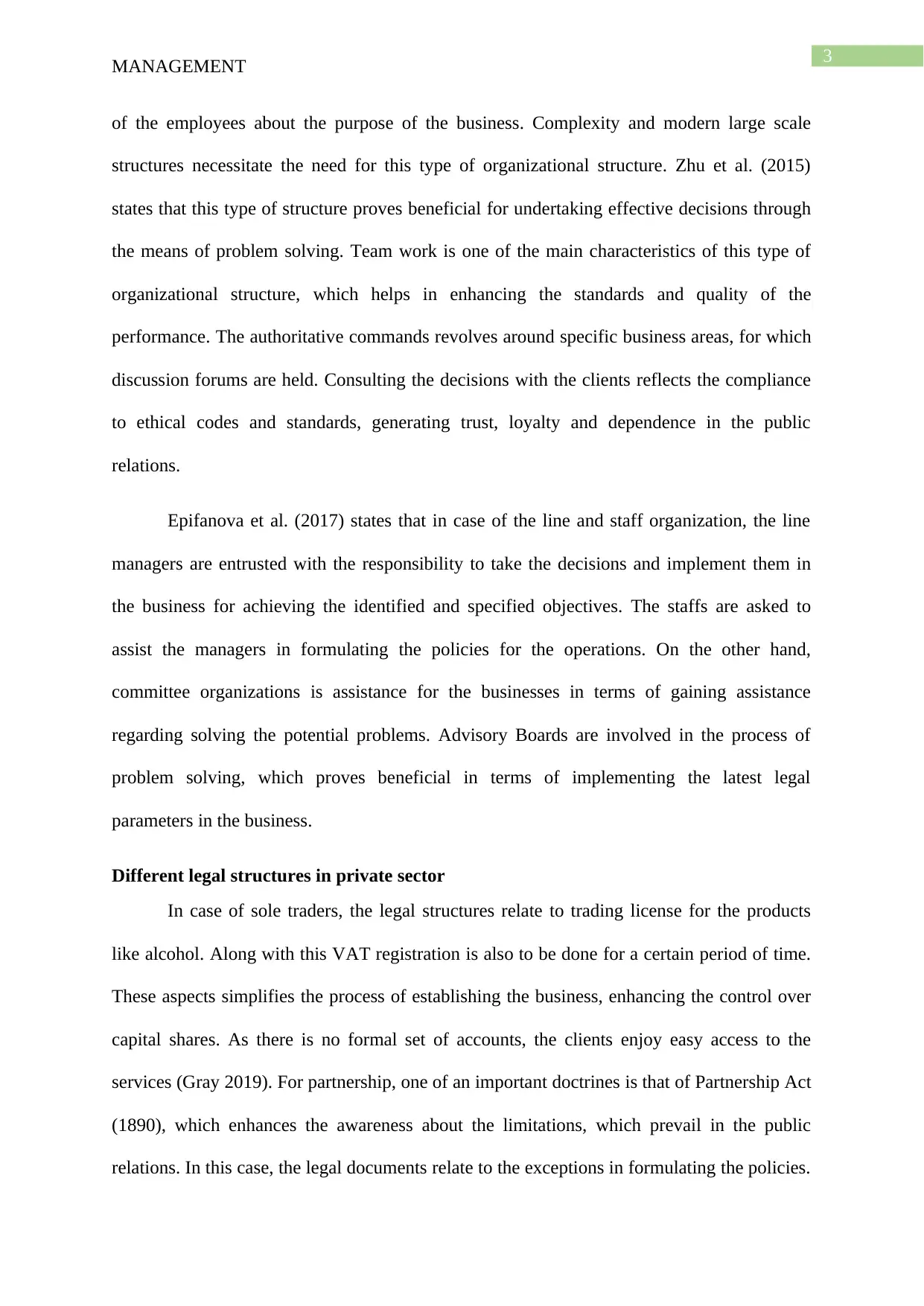
3
MANAGEMENT
of the employees about the purpose of the business. Complexity and modern large scale
structures necessitate the need for this type of organizational structure. Zhu et al. (2015)
states that this type of structure proves beneficial for undertaking effective decisions through
the means of problem solving. Team work is one of the main characteristics of this type of
organizational structure, which helps in enhancing the standards and quality of the
performance. The authoritative commands revolves around specific business areas, for which
discussion forums are held. Consulting the decisions with the clients reflects the compliance
to ethical codes and standards, generating trust, loyalty and dependence in the public
relations.
Epifanova et al. (2017) states that in case of the line and staff organization, the line
managers are entrusted with the responsibility to take the decisions and implement them in
the business for achieving the identified and specified objectives. The staffs are asked to
assist the managers in formulating the policies for the operations. On the other hand,
committee organizations is assistance for the businesses in terms of gaining assistance
regarding solving the potential problems. Advisory Boards are involved in the process of
problem solving, which proves beneficial in terms of implementing the latest legal
parameters in the business.
Different legal structures in private sector
In case of sole traders, the legal structures relate to trading license for the products
like alcohol. Along with this VAT registration is also to be done for a certain period of time.
These aspects simplifies the process of establishing the business, enhancing the control over
capital shares. As there is no formal set of accounts, the clients enjoy easy access to the
services (Gray 2019). For partnership, one of an important doctrines is that of Partnership Act
(1890), which enhances the awareness about the limitations, which prevail in the public
relations. In this case, the legal documents relate to the exceptions in formulating the policies.
MANAGEMENT
of the employees about the purpose of the business. Complexity and modern large scale
structures necessitate the need for this type of organizational structure. Zhu et al. (2015)
states that this type of structure proves beneficial for undertaking effective decisions through
the means of problem solving. Team work is one of the main characteristics of this type of
organizational structure, which helps in enhancing the standards and quality of the
performance. The authoritative commands revolves around specific business areas, for which
discussion forums are held. Consulting the decisions with the clients reflects the compliance
to ethical codes and standards, generating trust, loyalty and dependence in the public
relations.
Epifanova et al. (2017) states that in case of the line and staff organization, the line
managers are entrusted with the responsibility to take the decisions and implement them in
the business for achieving the identified and specified objectives. The staffs are asked to
assist the managers in formulating the policies for the operations. On the other hand,
committee organizations is assistance for the businesses in terms of gaining assistance
regarding solving the potential problems. Advisory Boards are involved in the process of
problem solving, which proves beneficial in terms of implementing the latest legal
parameters in the business.
Different legal structures in private sector
In case of sole traders, the legal structures relate to trading license for the products
like alcohol. Along with this VAT registration is also to be done for a certain period of time.
These aspects simplifies the process of establishing the business, enhancing the control over
capital shares. As there is no formal set of accounts, the clients enjoy easy access to the
services (Gray 2019). For partnership, one of an important doctrines is that of Partnership Act
(1890), which enhances the awareness about the limitations, which prevail in the public
relations. In this case, the legal documents relate to the exceptions in formulating the policies.
Paraphrase This Document
Need a fresh take? Get an instant paraphrase of this document with our AI Paraphraser
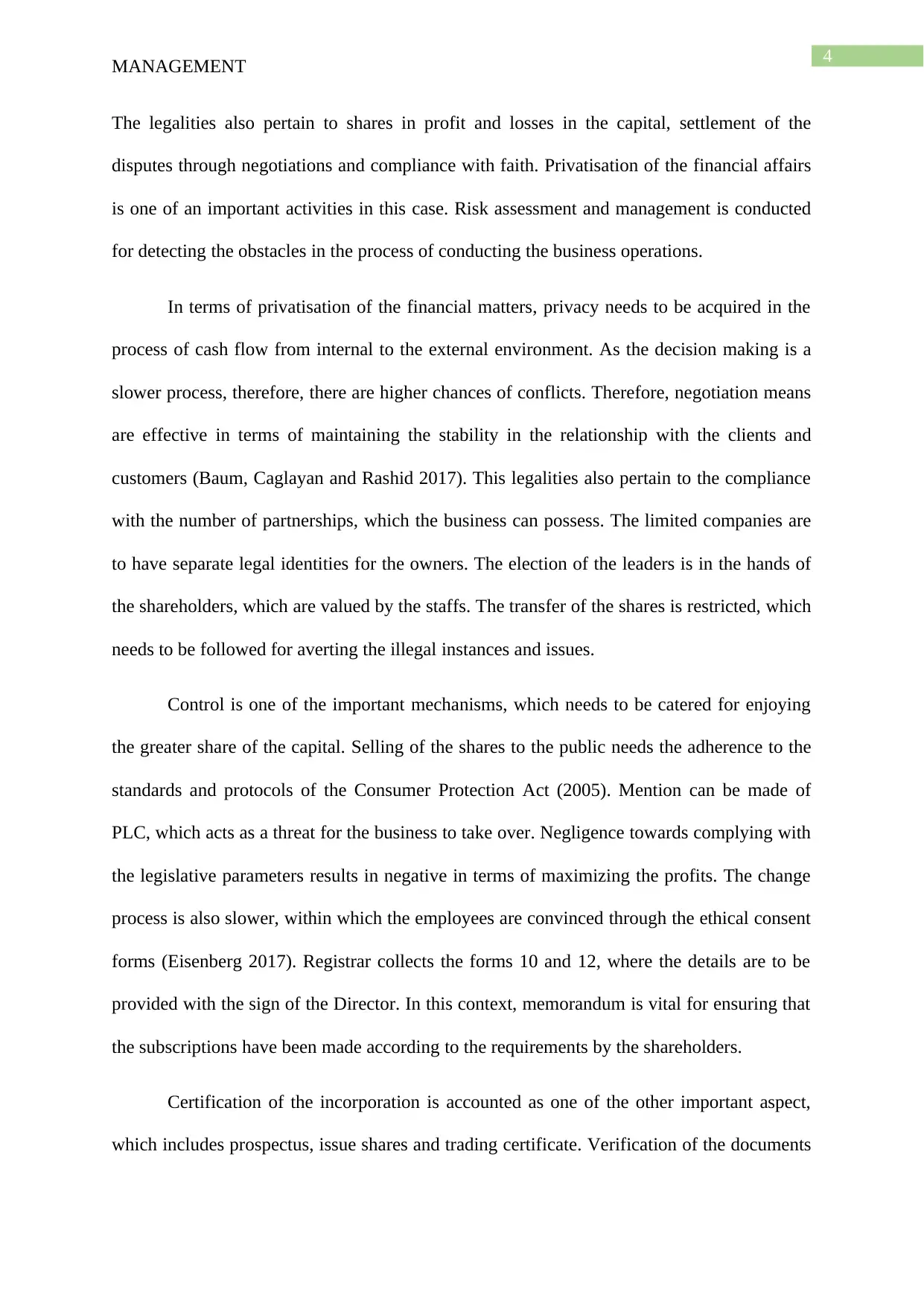
4
MANAGEMENT
The legalities also pertain to shares in profit and losses in the capital, settlement of the
disputes through negotiations and compliance with faith. Privatisation of the financial affairs
is one of an important activities in this case. Risk assessment and management is conducted
for detecting the obstacles in the process of conducting the business operations.
In terms of privatisation of the financial matters, privacy needs to be acquired in the
process of cash flow from internal to the external environment. As the decision making is a
slower process, therefore, there are higher chances of conflicts. Therefore, negotiation means
are effective in terms of maintaining the stability in the relationship with the clients and
customers (Baum, Caglayan and Rashid 2017). This legalities also pertain to the compliance
with the number of partnerships, which the business can possess. The limited companies are
to have separate legal identities for the owners. The election of the leaders is in the hands of
the shareholders, which are valued by the staffs. The transfer of the shares is restricted, which
needs to be followed for averting the illegal instances and issues.
Control is one of the important mechanisms, which needs to be catered for enjoying
the greater share of the capital. Selling of the shares to the public needs the adherence to the
standards and protocols of the Consumer Protection Act (2005). Mention can be made of
PLC, which acts as a threat for the business to take over. Negligence towards complying with
the legislative parameters results in negative in terms of maximizing the profits. The change
process is also slower, within which the employees are convinced through the ethical consent
forms (Eisenberg 2017). Registrar collects the forms 10 and 12, where the details are to be
provided with the sign of the Director. In this context, memorandum is vital for ensuring that
the subscriptions have been made according to the requirements by the shareholders.
Certification of the incorporation is accounted as one of the other important aspect,
which includes prospectus, issue shares and trading certificate. Verification of the documents
MANAGEMENT
The legalities also pertain to shares in profit and losses in the capital, settlement of the
disputes through negotiations and compliance with faith. Privatisation of the financial affairs
is one of an important activities in this case. Risk assessment and management is conducted
for detecting the obstacles in the process of conducting the business operations.
In terms of privatisation of the financial matters, privacy needs to be acquired in the
process of cash flow from internal to the external environment. As the decision making is a
slower process, therefore, there are higher chances of conflicts. Therefore, negotiation means
are effective in terms of maintaining the stability in the relationship with the clients and
customers (Baum, Caglayan and Rashid 2017). This legalities also pertain to the compliance
with the number of partnerships, which the business can possess. The limited companies are
to have separate legal identities for the owners. The election of the leaders is in the hands of
the shareholders, which are valued by the staffs. The transfer of the shares is restricted, which
needs to be followed for averting the illegal instances and issues.
Control is one of the important mechanisms, which needs to be catered for enjoying
the greater share of the capital. Selling of the shares to the public needs the adherence to the
standards and protocols of the Consumer Protection Act (2005). Mention can be made of
PLC, which acts as a threat for the business to take over. Negligence towards complying with
the legislative parameters results in negative in terms of maximizing the profits. The change
process is also slower, within which the employees are convinced through the ethical consent
forms (Eisenberg 2017). Registrar collects the forms 10 and 12, where the details are to be
provided with the sign of the Director. In this context, memorandum is vital for ensuring that
the subscriptions have been made according to the requirements by the shareholders.
Certification of the incorporation is accounted as one of the other important aspect,
which includes prospectus, issue shares and trading certificate. Verification of the documents
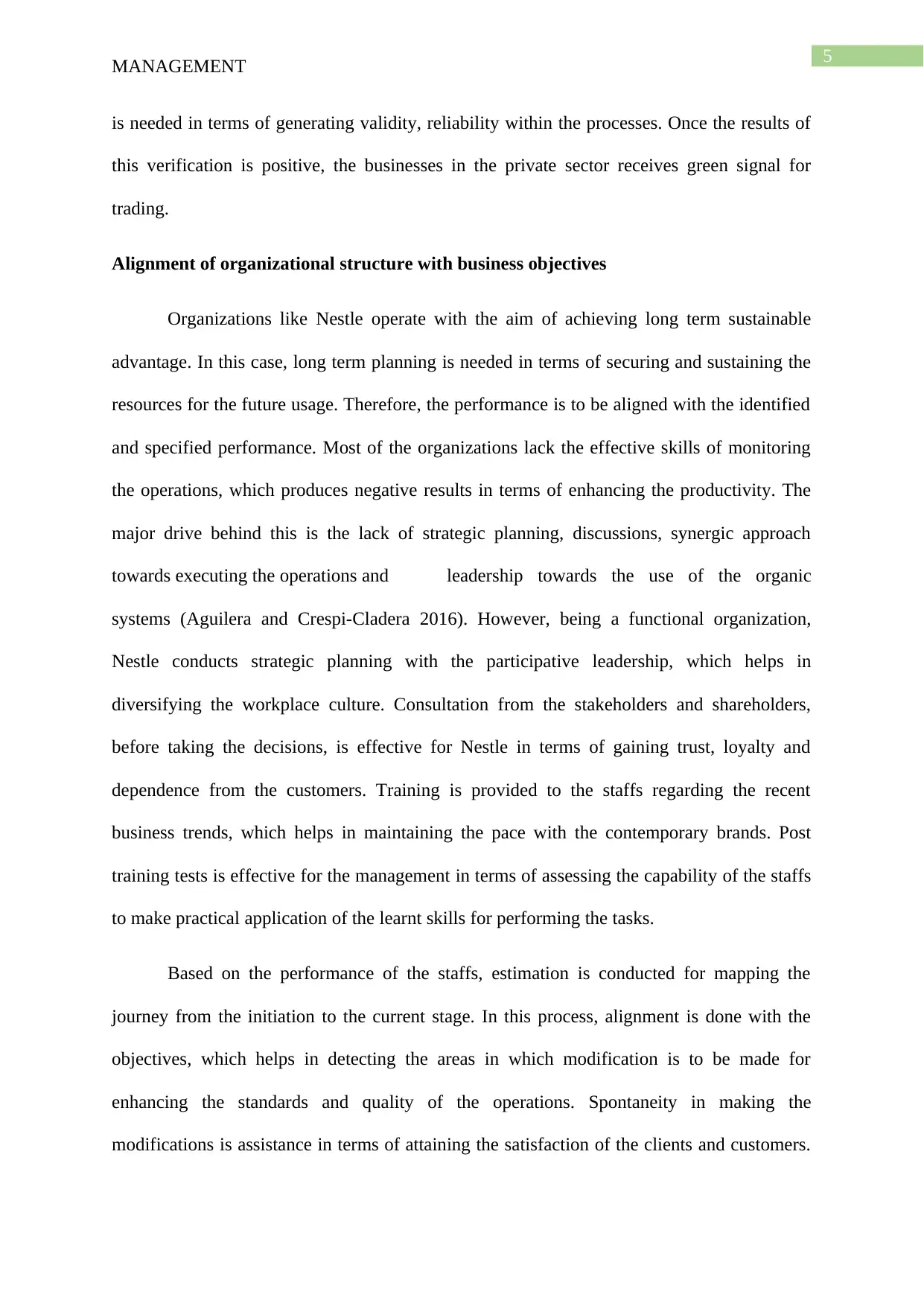
5
MANAGEMENT
is needed in terms of generating validity, reliability within the processes. Once the results of
this verification is positive, the businesses in the private sector receives green signal for
trading.
Alignment of organizational structure with business objectives
Organizations like Nestle operate with the aim of achieving long term sustainable
advantage. In this case, long term planning is needed in terms of securing and sustaining the
resources for the future usage. Therefore, the performance is to be aligned with the identified
and specified performance. Most of the organizations lack the effective skills of monitoring
the operations, which produces negative results in terms of enhancing the productivity. The
major drive behind this is the lack of strategic planning, discussions, synergic approach
towards executing the operations and leadership towards the use of the organic
systems (Aguilera and Crespi-Cladera 2016). However, being a functional organization,
Nestle conducts strategic planning with the participative leadership, which helps in
diversifying the workplace culture. Consultation from the stakeholders and shareholders,
before taking the decisions, is effective for Nestle in terms of gaining trust, loyalty and
dependence from the customers. Training is provided to the staffs regarding the recent
business trends, which helps in maintaining the pace with the contemporary brands. Post
training tests is effective for the management in terms of assessing the capability of the staffs
to make practical application of the learnt skills for performing the tasks.
Based on the performance of the staffs, estimation is conducted for mapping the
journey from the initiation to the current stage. In this process, alignment is done with the
objectives, which helps in detecting the areas in which modification is to be made for
enhancing the standards and quality of the operations. Spontaneity in making the
modifications is assistance in terms of attaining the satisfaction of the clients and customers.
MANAGEMENT
is needed in terms of generating validity, reliability within the processes. Once the results of
this verification is positive, the businesses in the private sector receives green signal for
trading.
Alignment of organizational structure with business objectives
Organizations like Nestle operate with the aim of achieving long term sustainable
advantage. In this case, long term planning is needed in terms of securing and sustaining the
resources for the future usage. Therefore, the performance is to be aligned with the identified
and specified performance. Most of the organizations lack the effective skills of monitoring
the operations, which produces negative results in terms of enhancing the productivity. The
major drive behind this is the lack of strategic planning, discussions, synergic approach
towards executing the operations and leadership towards the use of the organic
systems (Aguilera and Crespi-Cladera 2016). However, being a functional organization,
Nestle conducts strategic planning with the participative leadership, which helps in
diversifying the workplace culture. Consultation from the stakeholders and shareholders,
before taking the decisions, is effective for Nestle in terms of gaining trust, loyalty and
dependence from the customers. Training is provided to the staffs regarding the recent
business trends, which helps in maintaining the pace with the contemporary brands. Post
training tests is effective for the management in terms of assessing the capability of the staffs
to make practical application of the learnt skills for performing the tasks.
Based on the performance of the staffs, estimation is conducted for mapping the
journey from the initiation to the current stage. In this process, alignment is done with the
objectives, which helps in detecting the areas in which modification is to be made for
enhancing the standards and quality of the operations. Spontaneity in making the
modifications is assistance in terms of attaining the satisfaction of the clients and customers.
⊘ This is a preview!⊘
Do you want full access?
Subscribe today to unlock all pages.

Trusted by 1+ million students worldwide
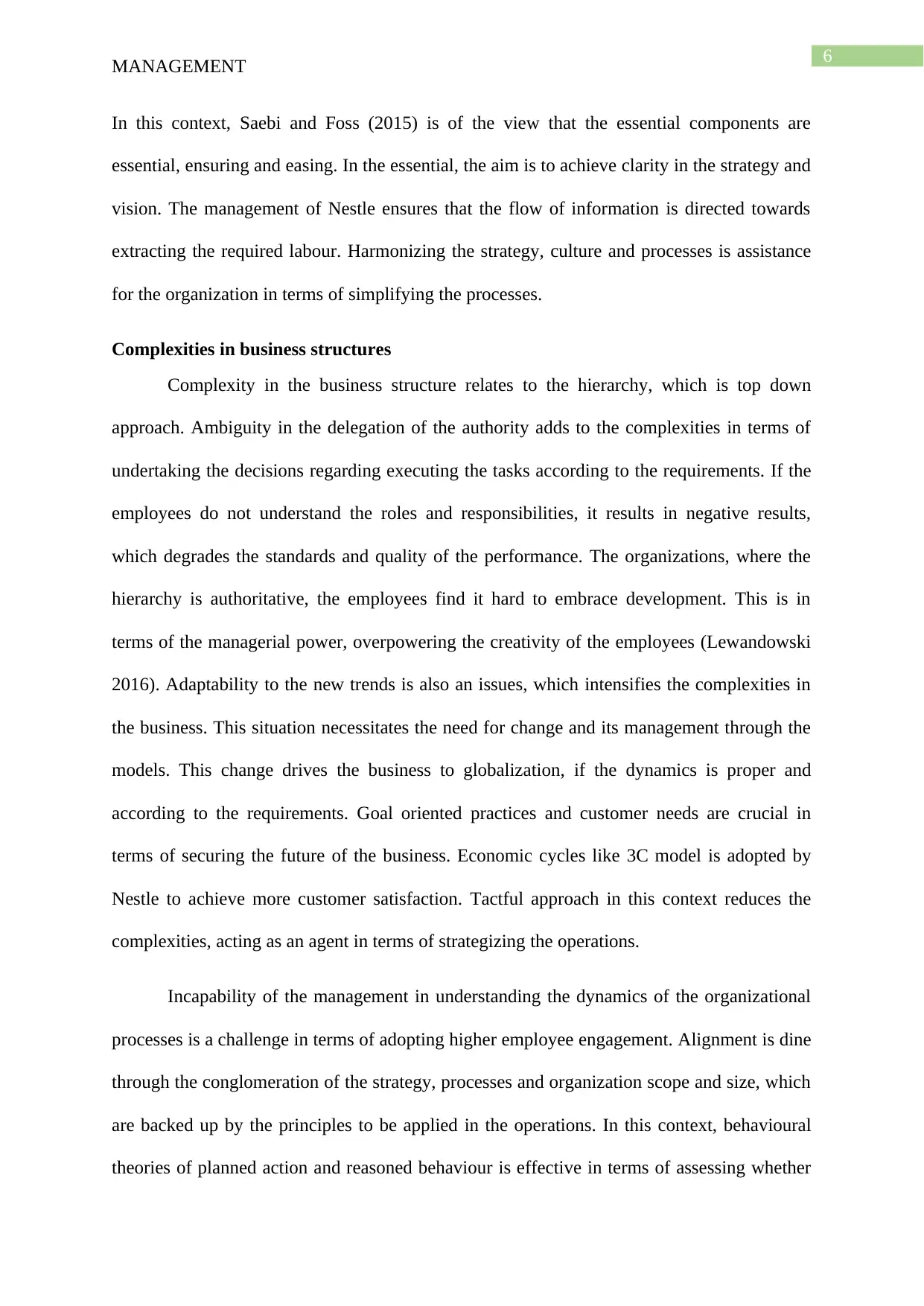
6
MANAGEMENT
In this context, Saebi and Foss (2015) is of the view that the essential components are
essential, ensuring and easing. In the essential, the aim is to achieve clarity in the strategy and
vision. The management of Nestle ensures that the flow of information is directed towards
extracting the required labour. Harmonizing the strategy, culture and processes is assistance
for the organization in terms of simplifying the processes.
Complexities in business structures
Complexity in the business structure relates to the hierarchy, which is top down
approach. Ambiguity in the delegation of the authority adds to the complexities in terms of
undertaking the decisions regarding executing the tasks according to the requirements. If the
employees do not understand the roles and responsibilities, it results in negative results,
which degrades the standards and quality of the performance. The organizations, where the
hierarchy is authoritative, the employees find it hard to embrace development. This is in
terms of the managerial power, overpowering the creativity of the employees (Lewandowski
2016). Adaptability to the new trends is also an issues, which intensifies the complexities in
the business. This situation necessitates the need for change and its management through the
models. This change drives the business to globalization, if the dynamics is proper and
according to the requirements. Goal oriented practices and customer needs are crucial in
terms of securing the future of the business. Economic cycles like 3C model is adopted by
Nestle to achieve more customer satisfaction. Tactful approach in this context reduces the
complexities, acting as an agent in terms of strategizing the operations.
Incapability of the management in understanding the dynamics of the organizational
processes is a challenge in terms of adopting higher employee engagement. Alignment is dine
through the conglomeration of the strategy, processes and organization scope and size, which
are backed up by the principles to be applied in the operations. In this context, behavioural
theories of planned action and reasoned behaviour is effective in terms of assessing whether
MANAGEMENT
In this context, Saebi and Foss (2015) is of the view that the essential components are
essential, ensuring and easing. In the essential, the aim is to achieve clarity in the strategy and
vision. The management of Nestle ensures that the flow of information is directed towards
extracting the required labour. Harmonizing the strategy, culture and processes is assistance
for the organization in terms of simplifying the processes.
Complexities in business structures
Complexity in the business structure relates to the hierarchy, which is top down
approach. Ambiguity in the delegation of the authority adds to the complexities in terms of
undertaking the decisions regarding executing the tasks according to the requirements. If the
employees do not understand the roles and responsibilities, it results in negative results,
which degrades the standards and quality of the performance. The organizations, where the
hierarchy is authoritative, the employees find it hard to embrace development. This is in
terms of the managerial power, overpowering the creativity of the employees (Lewandowski
2016). Adaptability to the new trends is also an issues, which intensifies the complexities in
the business. This situation necessitates the need for change and its management through the
models. This change drives the business to globalization, if the dynamics is proper and
according to the requirements. Goal oriented practices and customer needs are crucial in
terms of securing the future of the business. Economic cycles like 3C model is adopted by
Nestle to achieve more customer satisfaction. Tactful approach in this context reduces the
complexities, acting as an agent in terms of strategizing the operations.
Incapability of the management in understanding the dynamics of the organizational
processes is a challenge in terms of adopting higher employee engagement. Alignment is dine
through the conglomeration of the strategy, processes and organization scope and size, which
are backed up by the principles to be applied in the operations. In this context, behavioural
theories of planned action and reasoned behaviour is effective in terms of assessing whether
Paraphrase This Document
Need a fresh take? Get an instant paraphrase of this document with our AI Paraphraser
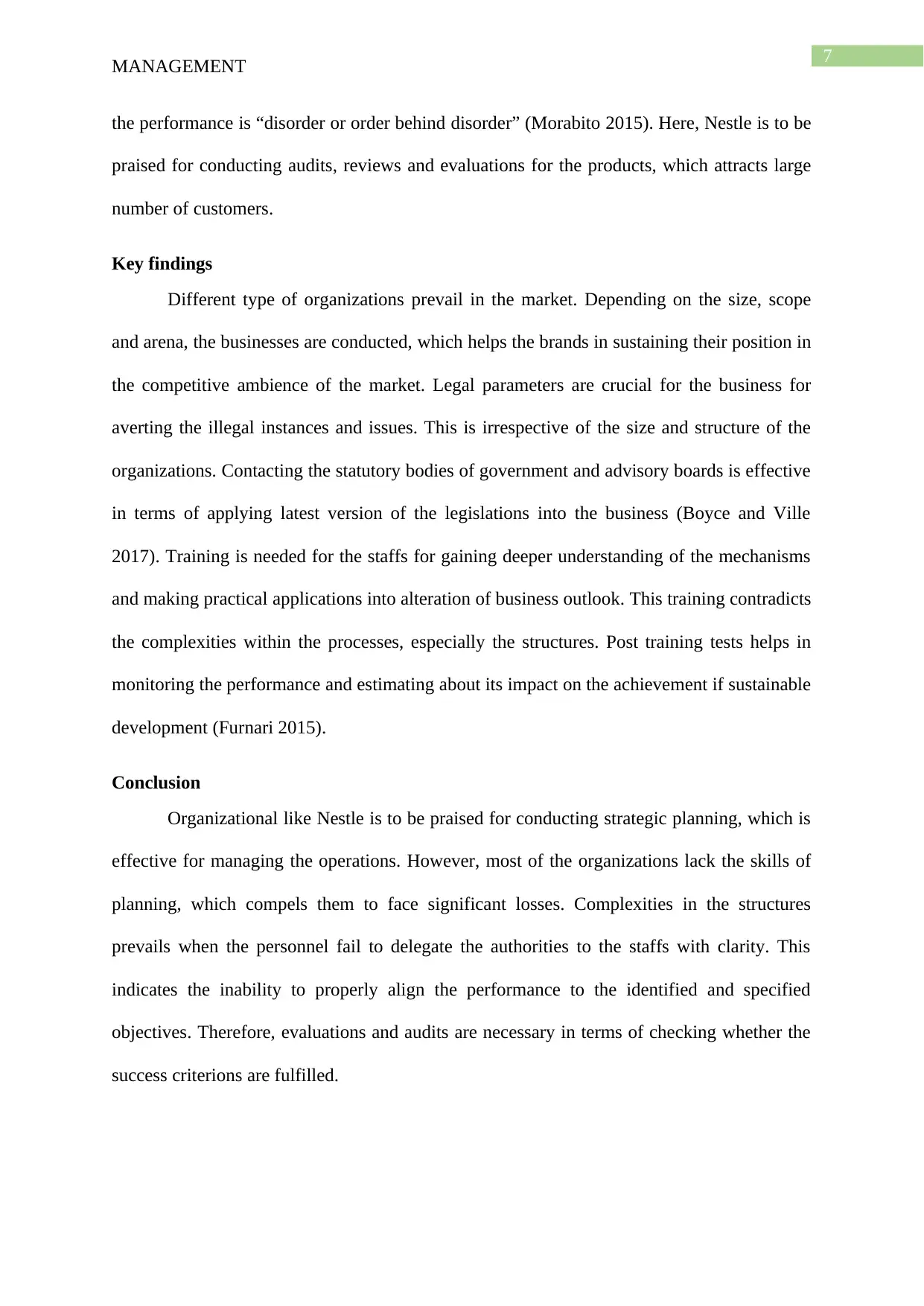
7
MANAGEMENT
the performance is “disorder or order behind disorder” (Morabito 2015). Here, Nestle is to be
praised for conducting audits, reviews and evaluations for the products, which attracts large
number of customers.
Key findings
Different type of organizations prevail in the market. Depending on the size, scope
and arena, the businesses are conducted, which helps the brands in sustaining their position in
the competitive ambience of the market. Legal parameters are crucial for the business for
averting the illegal instances and issues. This is irrespective of the size and structure of the
organizations. Contacting the statutory bodies of government and advisory boards is effective
in terms of applying latest version of the legislations into the business (Boyce and Ville
2017). Training is needed for the staffs for gaining deeper understanding of the mechanisms
and making practical applications into alteration of business outlook. This training contradicts
the complexities within the processes, especially the structures. Post training tests helps in
monitoring the performance and estimating about its impact on the achievement if sustainable
development (Furnari 2015).
Conclusion
Organizational like Nestle is to be praised for conducting strategic planning, which is
effective for managing the operations. However, most of the organizations lack the skills of
planning, which compels them to face significant losses. Complexities in the structures
prevails when the personnel fail to delegate the authorities to the staffs with clarity. This
indicates the inability to properly align the performance to the identified and specified
objectives. Therefore, evaluations and audits are necessary in terms of checking whether the
success criterions are fulfilled.
MANAGEMENT
the performance is “disorder or order behind disorder” (Morabito 2015). Here, Nestle is to be
praised for conducting audits, reviews and evaluations for the products, which attracts large
number of customers.
Key findings
Different type of organizations prevail in the market. Depending on the size, scope
and arena, the businesses are conducted, which helps the brands in sustaining their position in
the competitive ambience of the market. Legal parameters are crucial for the business for
averting the illegal instances and issues. This is irrespective of the size and structure of the
organizations. Contacting the statutory bodies of government and advisory boards is effective
in terms of applying latest version of the legislations into the business (Boyce and Ville
2017). Training is needed for the staffs for gaining deeper understanding of the mechanisms
and making practical applications into alteration of business outlook. This training contradicts
the complexities within the processes, especially the structures. Post training tests helps in
monitoring the performance and estimating about its impact on the achievement if sustainable
development (Furnari 2015).
Conclusion
Organizational like Nestle is to be praised for conducting strategic planning, which is
effective for managing the operations. However, most of the organizations lack the skills of
planning, which compels them to face significant losses. Complexities in the structures
prevails when the personnel fail to delegate the authorities to the staffs with clarity. This
indicates the inability to properly align the performance to the identified and specified
objectives. Therefore, evaluations and audits are necessary in terms of checking whether the
success criterions are fulfilled.
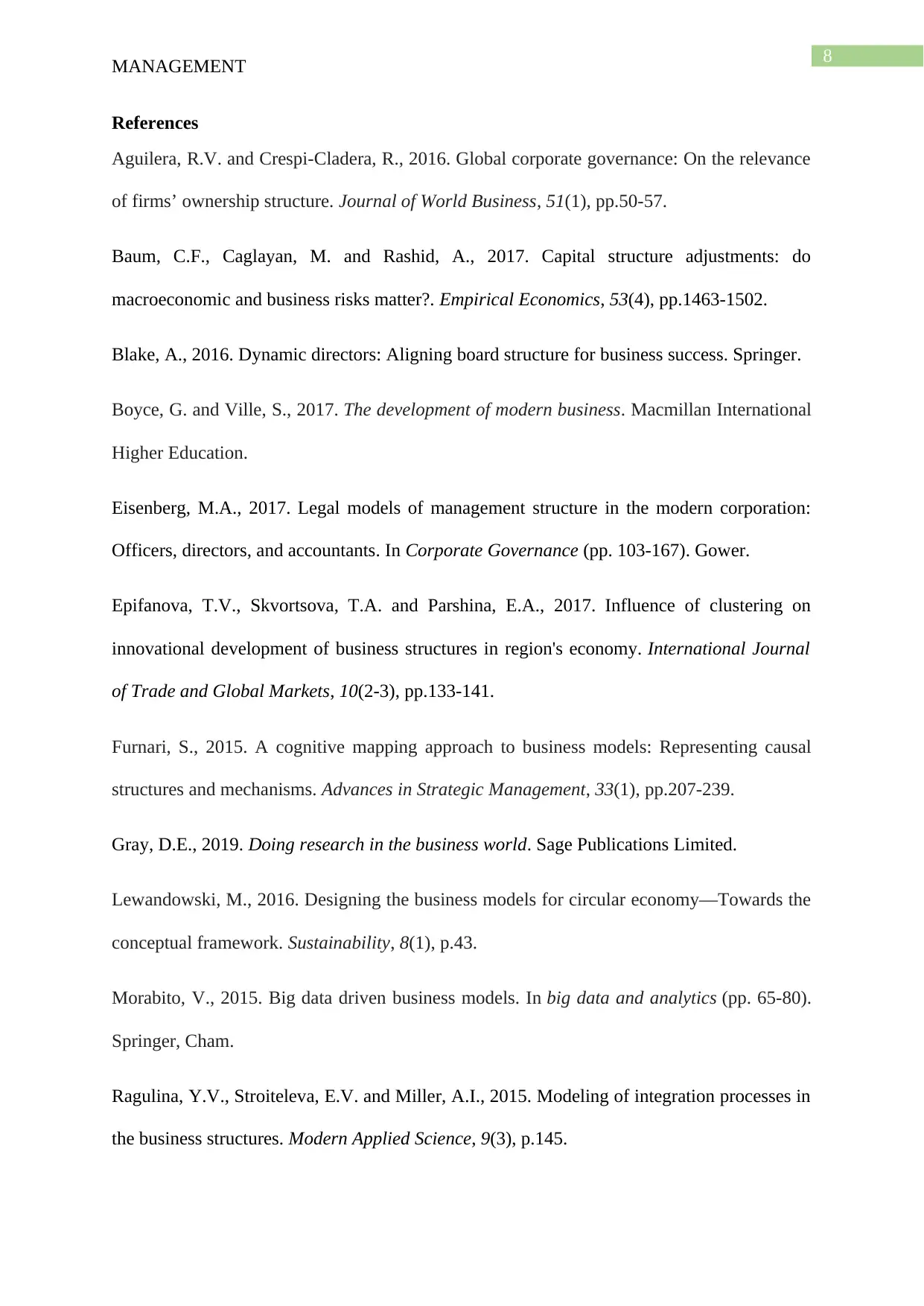
8
MANAGEMENT
References
Aguilera, R.V. and Crespi-Cladera, R., 2016. Global corporate governance: On the relevance
of firms’ ownership structure. Journal of World Business, 51(1), pp.50-57.
Baum, C.F., Caglayan, M. and Rashid, A., 2017. Capital structure adjustments: do
macroeconomic and business risks matter?. Empirical Economics, 53(4), pp.1463-1502.
Blake, A., 2016. Dynamic directors: Aligning board structure for business success. Springer.
Boyce, G. and Ville, S., 2017. The development of modern business. Macmillan International
Higher Education.
Eisenberg, M.A., 2017. Legal models of management structure in the modern corporation:
Officers, directors, and accountants. In Corporate Governance (pp. 103-167). Gower.
Epifanova, T.V., Skvortsova, T.A. and Parshina, E.A., 2017. Influence of clustering on
innovational development of business structures in region's economy. International Journal
of Trade and Global Markets, 10(2-3), pp.133-141.
Furnari, S., 2015. A cognitive mapping approach to business models: Representing causal
structures and mechanisms. Advances in Strategic Management, 33(1), pp.207-239.
Gray, D.E., 2019. Doing research in the business world. Sage Publications Limited.
Lewandowski, M., 2016. Designing the business models for circular economy—Towards the
conceptual framework. Sustainability, 8(1), p.43.
Morabito, V., 2015. Big data driven business models. In big data and analytics (pp. 65-80).
Springer, Cham.
Ragulina, Y.V., Stroiteleva, E.V. and Miller, A.I., 2015. Modeling of integration processes in
the business structures. Modern Applied Science, 9(3), p.145.
MANAGEMENT
References
Aguilera, R.V. and Crespi-Cladera, R., 2016. Global corporate governance: On the relevance
of firms’ ownership structure. Journal of World Business, 51(1), pp.50-57.
Baum, C.F., Caglayan, M. and Rashid, A., 2017. Capital structure adjustments: do
macroeconomic and business risks matter?. Empirical Economics, 53(4), pp.1463-1502.
Blake, A., 2016. Dynamic directors: Aligning board structure for business success. Springer.
Boyce, G. and Ville, S., 2017. The development of modern business. Macmillan International
Higher Education.
Eisenberg, M.A., 2017. Legal models of management structure in the modern corporation:
Officers, directors, and accountants. In Corporate Governance (pp. 103-167). Gower.
Epifanova, T.V., Skvortsova, T.A. and Parshina, E.A., 2017. Influence of clustering on
innovational development of business structures in region's economy. International Journal
of Trade and Global Markets, 10(2-3), pp.133-141.
Furnari, S., 2015. A cognitive mapping approach to business models: Representing causal
structures and mechanisms. Advances in Strategic Management, 33(1), pp.207-239.
Gray, D.E., 2019. Doing research in the business world. Sage Publications Limited.
Lewandowski, M., 2016. Designing the business models for circular economy—Towards the
conceptual framework. Sustainability, 8(1), p.43.
Morabito, V., 2015. Big data driven business models. In big data and analytics (pp. 65-80).
Springer, Cham.
Ragulina, Y.V., Stroiteleva, E.V. and Miller, A.I., 2015. Modeling of integration processes in
the business structures. Modern Applied Science, 9(3), p.145.
⊘ This is a preview!⊘
Do you want full access?
Subscribe today to unlock all pages.

Trusted by 1+ million students worldwide
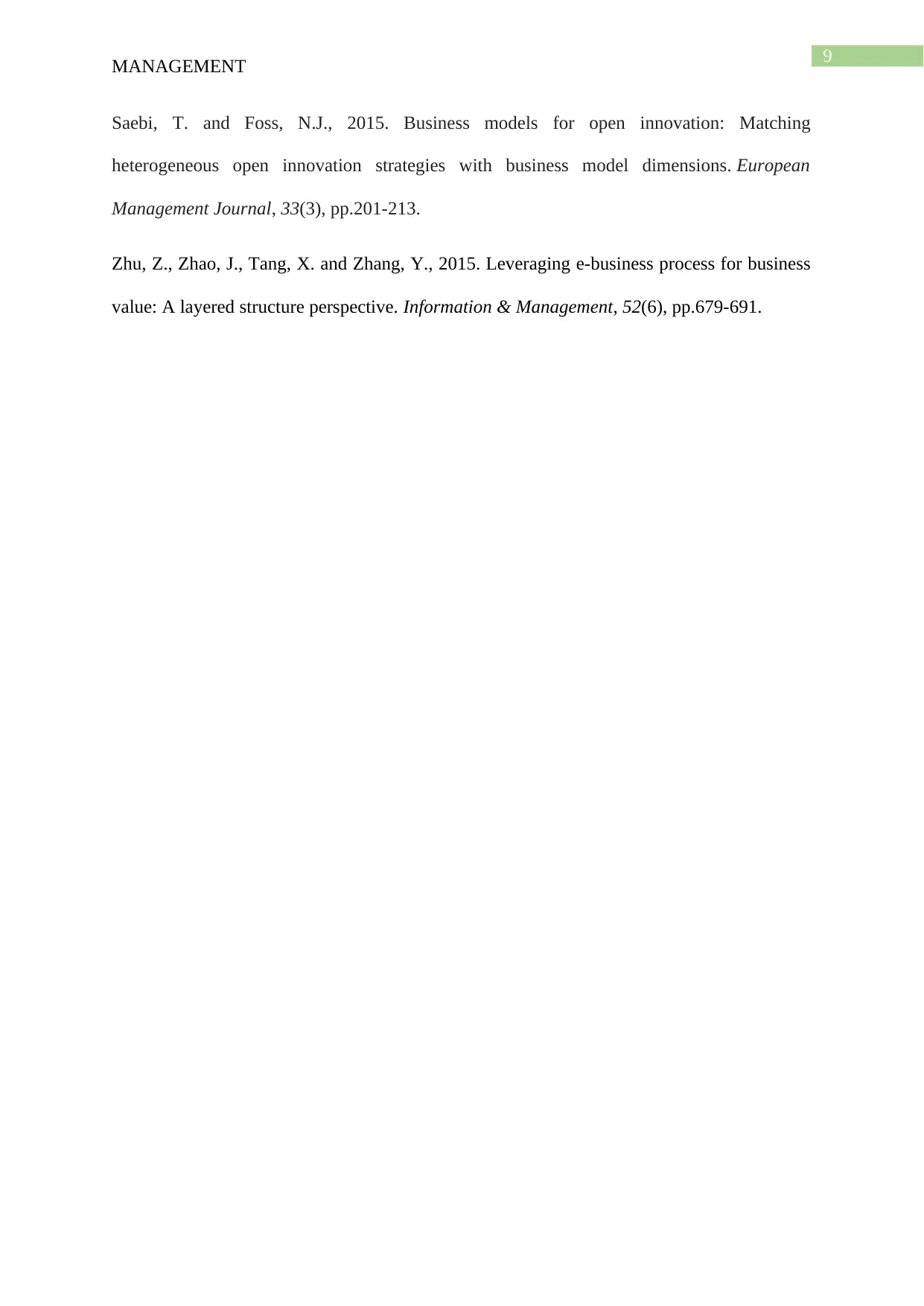
9
MANAGEMENT
Saebi, T. and Foss, N.J., 2015. Business models for open innovation: Matching
heterogeneous open innovation strategies with business model dimensions. European
Management Journal, 33(3), pp.201-213.
Zhu, Z., Zhao, J., Tang, X. and Zhang, Y., 2015. Leveraging e-business process for business
value: A layered structure perspective. Information & Management, 52(6), pp.679-691.
MANAGEMENT
Saebi, T. and Foss, N.J., 2015. Business models for open innovation: Matching
heterogeneous open innovation strategies with business model dimensions. European
Management Journal, 33(3), pp.201-213.
Zhu, Z., Zhao, J., Tang, X. and Zhang, Y., 2015. Leveraging e-business process for business
value: A layered structure perspective. Information & Management, 52(6), pp.679-691.
Paraphrase This Document
Need a fresh take? Get an instant paraphrase of this document with our AI Paraphraser
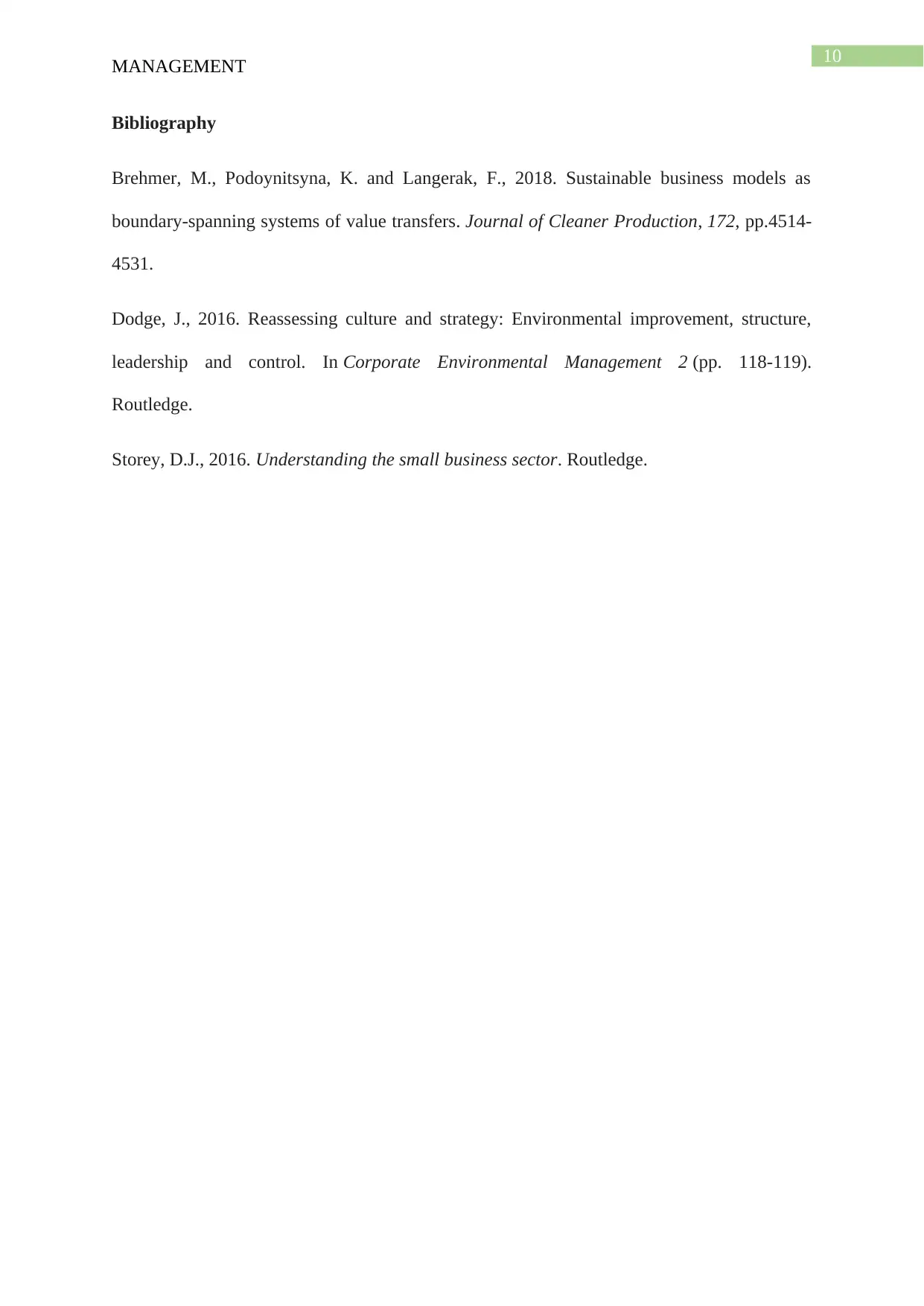
10
MANAGEMENT
Bibliography
Brehmer, M., Podoynitsyna, K. and Langerak, F., 2018. Sustainable business models as
boundary-spanning systems of value transfers. Journal of Cleaner Production, 172, pp.4514-
4531.
Dodge, J., 2016. Reassessing culture and strategy: Environmental improvement, structure,
leadership and control. In Corporate Environmental Management 2 (pp. 118-119).
Routledge.
Storey, D.J., 2016. Understanding the small business sector. Routledge.
MANAGEMENT
Bibliography
Brehmer, M., Podoynitsyna, K. and Langerak, F., 2018. Sustainable business models as
boundary-spanning systems of value transfers. Journal of Cleaner Production, 172, pp.4514-
4531.
Dodge, J., 2016. Reassessing culture and strategy: Environmental improvement, structure,
leadership and control. In Corporate Environmental Management 2 (pp. 118-119).
Routledge.
Storey, D.J., 2016. Understanding the small business sector. Routledge.
1 out of 11
Related Documents
Your All-in-One AI-Powered Toolkit for Academic Success.
+13062052269
info@desklib.com
Available 24*7 on WhatsApp / Email
![[object Object]](/_next/static/media/star-bottom.7253800d.svg)
Unlock your academic potential
Copyright © 2020–2025 A2Z Services. All Rights Reserved. Developed and managed by ZUCOL.




